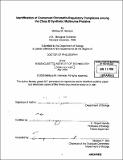| dc.contributor.advisor | H. Robert Horvitz. | en_US |
| dc.contributor.author | Harrison, Melissa M | en_US |
| dc.contributor.other | Massachusetts Institute of Technology. Dept. of Biology. | en_US |
| dc.date.accessioned | 2007-04-20T15:57:56Z | |
| dc.date.available | 2007-04-20T15:57:56Z | |
| dc.date.copyright | 2006 | en_US |
| dc.date.issued | 2006 | en_US |
| dc.identifier.uri | http://hdl.handle.net/1721.1/37260 | |
| dc.description | Thesis (Ph. D.)--Massachusetts Institute of Technology, Dept. of Biology, 2006. | en_US |
| dc.description | Includes bibliographical references. | en_US |
| dc.description.abstract | The class A, B, and C synthetic Multivulva (synMuv) genes act redundantly to antagonize Ras-mediated vulval induction in C. elegans. Many of these genes encode proteins that are likely to function in transcriptional repression and chromatin remodeling. The class B synMuv protein LIN-35 is similar to the mammalian tumor suppressor Rb. Studies of mammalian systems have identified many chromatin-remodeling factors that are recruited to promoters through association with Rb or other pocket proteins. We have identified a complex of at least seven class B synMuv proteins, including LIN-35 Rb. While this complex contains proteins such as DPL-1 DP and LIN-53 RbAp48 that were thought to interact with LIN-35 Rb based on similarities to mammalian systems, it also includes four additional proteins that were not previously known to be associated with pocket proteins- LIN-9, LIN-37, LIN-52, and LIN-54. We have named this complex the DRM complex for DP, Rb, and MuvB, complex. As similar protein complexes were simultaneously identified in flies, and these proteins all have mammalian homologs, it is likely that a similar complex exists in humans to regulate gene expression. | en_US |
| dc.description.abstract | (cont.) We have further shown that although pocket proteins are known to interact with histone deacetylases, in C. elegans the synMuv protein HDA-1 HDAC1 is not a component of the DRM complex although it is component of a NuRD-like complex. Furthermore, the NuRD-like complex has functions distinct from the DRM complex in vulval development. We have also characterized the class B synMuv protein LIN-61, which is not a core member of either the DRM or NuRD-like complexes. LIN-61 contains four malignant brain tumor (MBT) repeats, which are in multiple transcriptional repressors. Thus like other class B synMuv proteins, LIN-61 likely functions to repress transcription of genes that induce vulval development. Our biochemical and genetic characterizations of the synMuv genes have identified a new pocket protein-containing complex and have demonstrated the existence of multiple complexes among the class B synMuv proteins. Thus the many proteins that have previously been classified as class B synMuv proteins are likely to be functioning in independent complexes to regulate vulval development through transcriptional repression. | en_US |
| dc.description.statementofresponsibility | by Melissa M. Harrison. | en_US |
| dc.format.extent | 278, [1] leaves | en_US |
| dc.language.iso | eng | en_US |
| dc.publisher | Massachusetts Institute of Technology | en_US |
| dc.rights | M.I.T. theses are protected by copyright. They may be viewed from this source for any purpose, but reproduction or distribution in any format is prohibited without written permission. See provided URL for inquiries about permission. | en_US |
| dc.rights.uri | http://dspace.mit.edu/handle/1721.1/7582 | |
| dc.subject | Biology. | en_US |
| dc.title | Identification of conserved chromatin-regulatory complexes among the class B synthetic multivulva proteins | en_US |
| dc.type | Thesis | en_US |
| dc.description.degree | Ph.D. | en_US |
| dc.contributor.department | Massachusetts Institute of Technology. Department of Biology | |
| dc.identifier.oclc | 85846678 | en_US |

